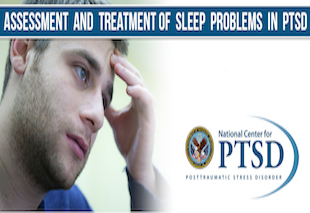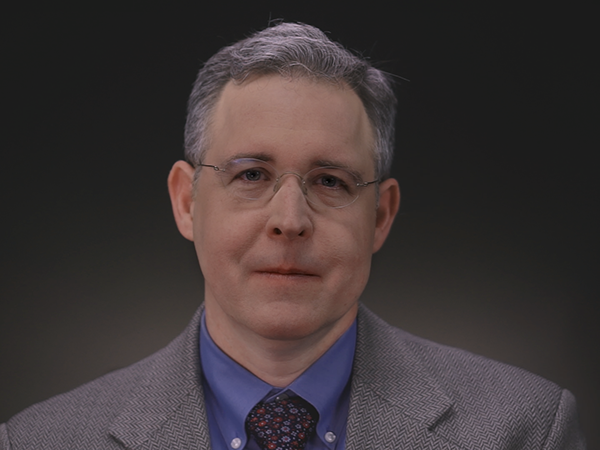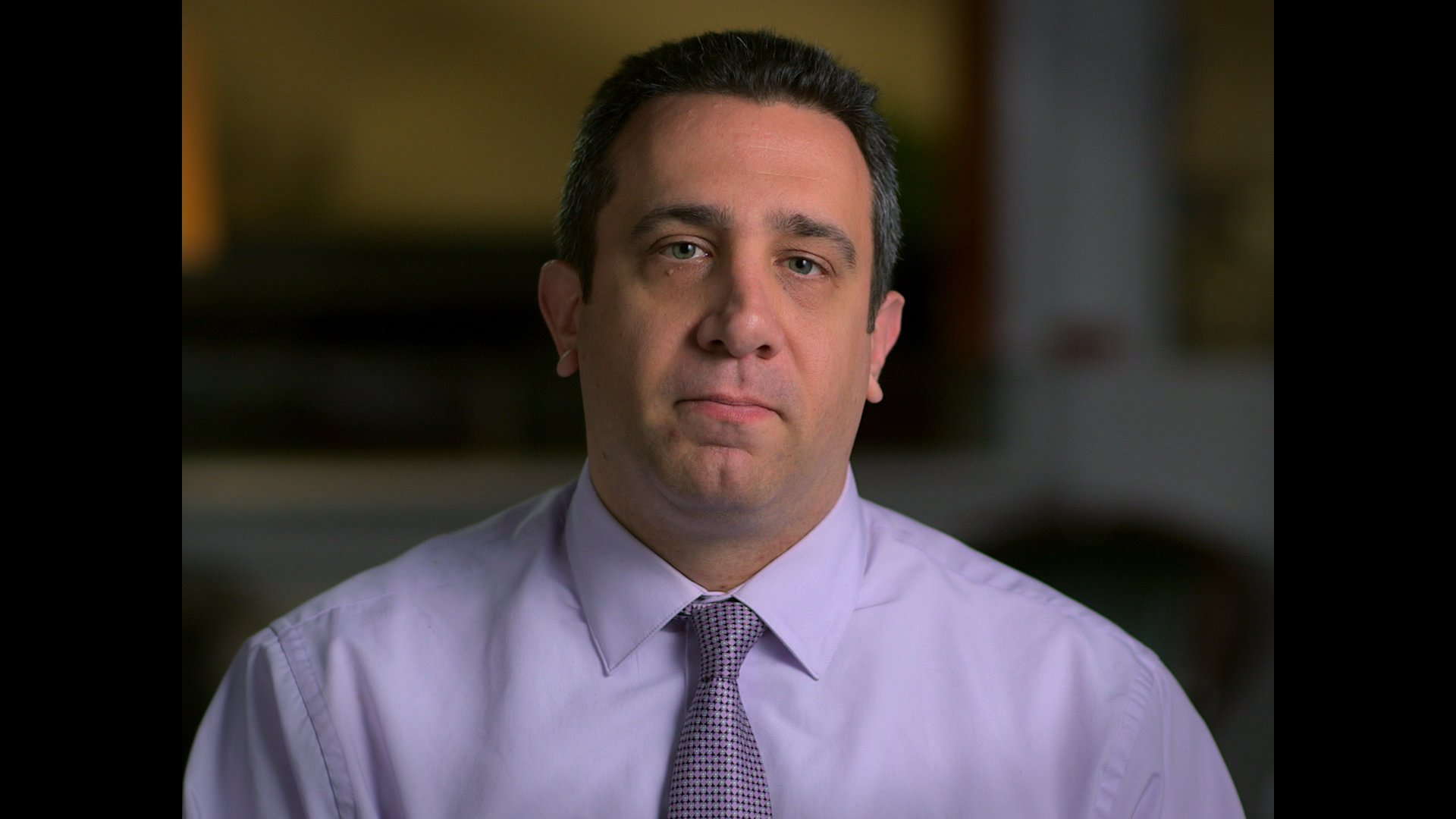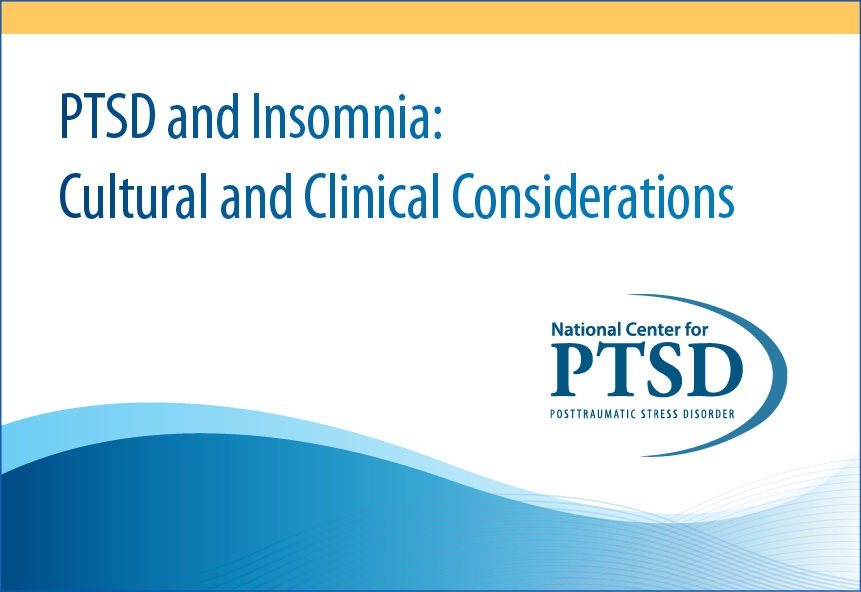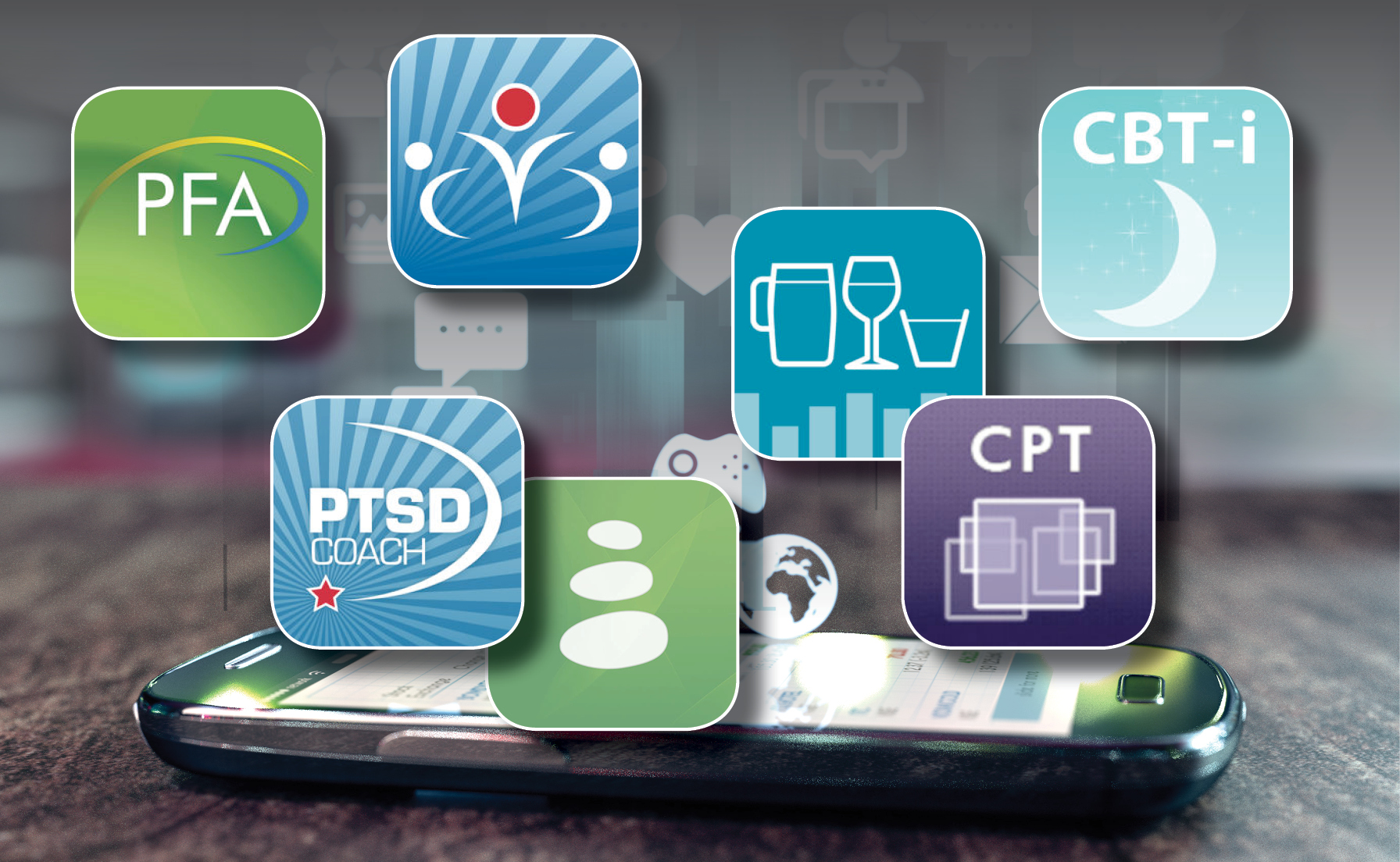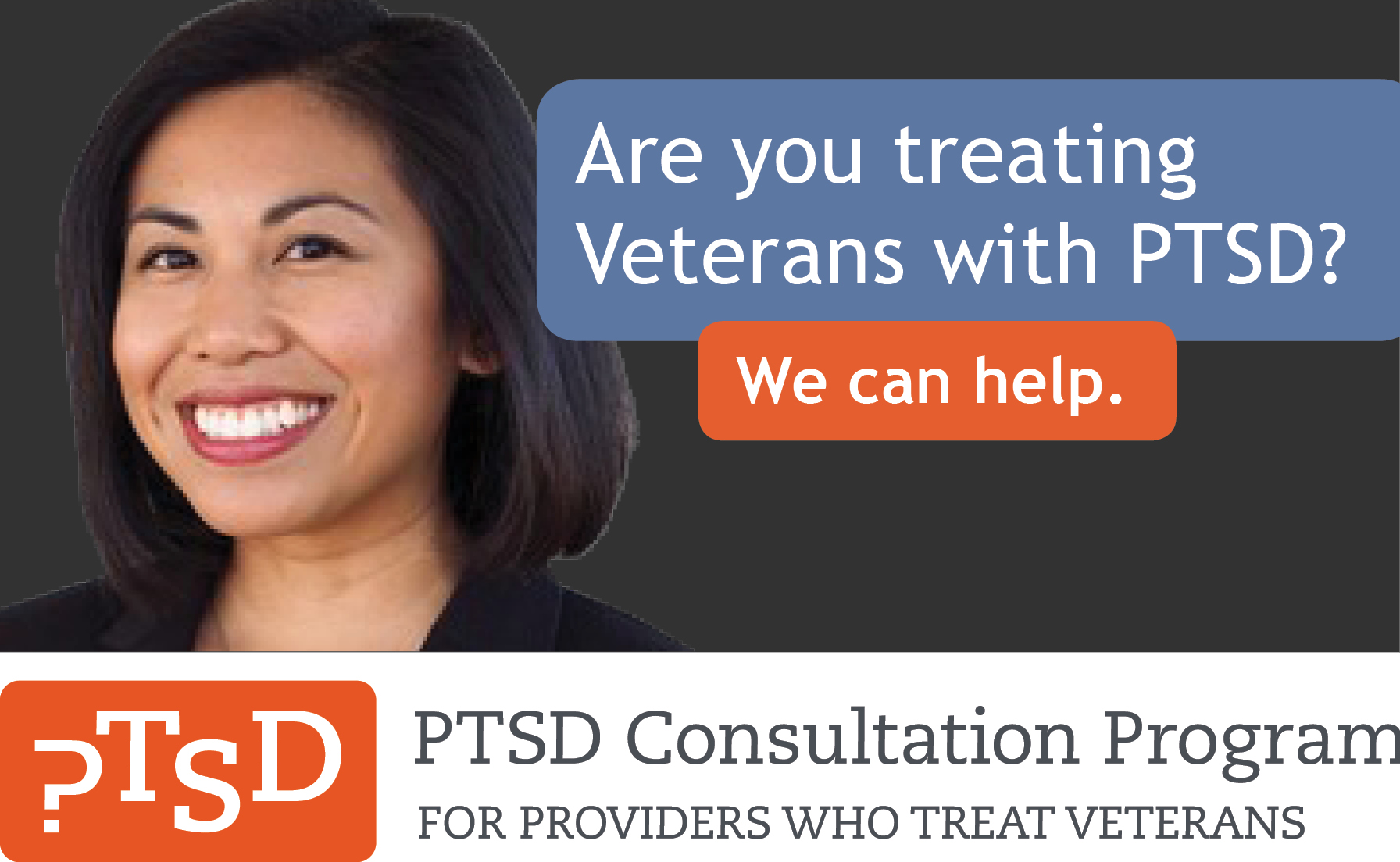PTSD: National Center for PTSD
Sleep Problems in Veterans with PTSD
Sleep Problems in Veterans with PTSD
Sleep problems—in particular chronic insomnia and nightmares—are frequently some of the most troubling aspects of PTSD. While these sleep problems are considered symptoms of PTSD, the evidence suggests that they tend to become independent problems over time that warrant sleep-focused assessment and treatment. There are both pharmacologic and cognitive behavioral treatment options available.
Continuing Education Course
Sleep Problems, Insomnia, and PTSD
This course includes videos that demonstrate assessment of sleep-related problems and the tools included in Cognitive Behavioral Therapy for Insomnia (CBT-I).
Prevalence of sleep problems in Veterans with PTSD
PTSD is unique among mental health disorders in that sleep problems are mentioned twice among its diagnostic criteria in DSM-5: the presence of insomnia qualifying as a symptom of an alteration in arousal and reactivity (hyperarousal) and the presence of frequent nightmares as an intrusion symptom. Insomnia is reported to occur in 90-100% of Vietnam era Veterans with PTSD (2,3). Insomnia was also the most commonly reported PTSD symptom in a survey of Veterans from Afghanistan and Iraq (OEF/OIF) (4). In the Millennium Cohort Study, 92% of active duty personnel with PTSD, compared to 28% of those without PTSD, reported clinically significant levels of insomnia (5).
It has been argued that sleep problems, rather than being just symptoms of PTSD, are a hallmark of the disorder (6). In support of this viewpoint, insomnia occurring in the acute aftermath of a traumatic event is a significant risk factor for the later development of PTSD in civilian (7,8) and active duty (9) populations. Despite the efficacy of evidence-based treatments for PTSD such as Prolonged Exposure (PE) or Cognitive Processing Therapy (CPT), the arousal and reactivity (hyperarousal) cluster symptoms that include sleep difficulties appear to be particularly difficult to resolve even after substantial PTSD improvement (10-13).
There are fewer data on the prevalence of chronic nightmares with PTSD. In the National Vietnam Veterans Readjustment Study, 52% of combat Veterans with PTSD reported significant nightmares (2). In a second study in the general community, 71% of individuals with PTSD endorsed nightmares; and, compared to civilians with PTSD, the nightmares of Veterans were more likely to be a replay of their trauma(s) (14). Posttraumatic nightmares are independently associated with daytime distress, and impaired functioning (15,16). Nightmares often do not fully remit with trauma-focused treatment although the degree of improvement is larger for nightmares than for insomnia in general (10,11,17).
An additional consideration is obstructive sleep apnea (OSA), which has been found to be more common among individuals with PTSD than the general population (18). Estimates vary based upon measurement (e.g., self-report, Apnea Hypopnea Index (AHI) thresholds); and, a meta-analysis found OSA rates were significantly higher in individuals with PTSD (ranging from 43.6% to 75.7% based upon AHI threshold) than without the diagnosis (19). Of note, the classic predictors of OSA—older age and body mass index (BMI), in particular—may not be as relevant among Veteran samples, as indicated by a study of OEF/OIF/OND Veterans (20).
Treatment of Insomnia in PTSD
There are two primary approaches to treating sleep problems in PTSD, psychotherapy and pharmacotherapy (i.e. sleep medications). To date, little is known about the efficacy of using both approaches concurrently. The recommended first-line treatment approach in the VA/DoD Clinical Practice Guideline (CPG) for PTSD is Cognitive Behavioral Therapy for Insomnia (CBT-I), when available (21), which is agreeable to the American College of Physicians first-line recommended treatment approach for sleep problems (22) and the VA/DoD Clinical Practice Guideline (CPG) for Chronic Insomnia Disorder and Obstructive Sleep Apnea recommendation for treating chronic insomnia (23).
Video
Working with Veterans Who Have Sleep Problems
Dr. Keith Warren shares tips on how to help Veterans overcome distress-related insomnia.
Cognitive Behavioral Therapy for Insomnia (CBT-I)
CBT-I is a series of strategies focused on stimulus control, sleep restriction, cognitive restructuring and sleep hygiene that can be delivered in either individual therapy or in a group format with 6-10 patients. Treatment length is typically 6 sessions but ranges from 4-8 sessions for most patients.
CBT-I has demonstrated efficacy in patients with primary insomnia as summarized in three meta-analyses (24-27). CBT-I demonstrated sustained improvement in chronic insomnia symptoms on follow-up assessments ranging from 1 to 3 years. The durability of treatment effects is a clear advantage over long-term pharmacotherapy, as are the lower risks of side effects and potential drug interactions. A randomized trial in Veterans with PTSD found that CBT-I led to greater improvements in sleep and disruptive sleep-related behaviors than wait list, demonstrating the efficacy of CBT-I in this population (28). Improvements were maintained at 6 months.
VA CBT-I rollout
To increase the availability of empirically supported treatments for sleep problems for Veterans, VA created a national dissemination program for CBT-I in 2010. Through this program, VA mental health providers can attend an intensive didactic and experiential training to learn the fundamentals of CBT-I. Participants then meet weekly by phone with a consultant who reviews recordings of CBT-I sessions to provide feedback to facilitate the learning process. This has been the largest CBT-I dissemination program ever conducted, with over 900 providers having completed the training, greatly increasing access to this treatment. Clinical outcomes data have been collected demonstrating large improvements in insomnia over the course of treatment (29,30). VA also released a treatment companion mobile app—CBT-I Coach—to assist during therapy.
Group CBT-I
CBT-I can be delivered both individually and in a group format. Within VA, a typical CBT-I group consists of 6-8 Veterans and meets weekly for about 6 weeks for 90 minutes per visit. The material is the same as in individual CBT-I with the added element of hearing the experiences of other Veterans with insomnia. A recent meta-analysis found that clinical improvements from group CBT-I were generally strong but slightly smaller than for individual treatment (31).
Telehealth delivery
Even with the national dissemination and the option to deliver CBT-I in a group, many VA facilities still do not have access to a trained CBT-I provider or the demand for treatment is greater than available provider time. The latter is not surprising given the high prevalence of insomnia in Veterans, especially among those with PTSD. Another option for increasing access to treatment is the use of clinical video telehealth (CVT) technology. CVT allows a provider to deliver real-time, interactive treatment to a patient in at another location (e.g., rural community clinics, home of the patient). This technology allows a provider to have a greater reach with treatment.
Sleep medications
There are several medications available that are either approved as sleep agents or that are used because of sedating side effects. In general, sleep medications carry significant side effects and are recommended for short-term use only. There are few clinical trials examining the efficacy and safety of these medications, particularly in Veterans with PTSD (32). Benzodiazepines are not recommended for the treatment of PTSD in the VA/DoD CPG for PTSD (21). The newly issued VA/DoD CPG for Insomnia Disorder and Obstructive Sleep Apnea suggests against the use of benzodiazepines for chronic insomnia disorder; and, the guideline suggests the use of a non-benzodiazepine benzodiazepine receptor agonist in patients who are offered a short-course of pharmacotherapy (23).
Benzodiazepine and non-benzodiazepine sedative hypnotics include temazepam, zolpidem, zaleplon, and eszopiclone. While these do initially promote sleep, after a few weeks of use, tolerance and physical dependence develop. Continued use is reinforced by a desire to avoid withdrawal symptoms and rebound insomnia. Other common adverse effects are cognitive impairment, daytime sedation, falls and fractures, disinhibition and increased mortality.
Video
Benzodiazepine Tolerance and Withdrawal
Dr. Ed MacPhee explains tolerance and risk of withdrawal with benzodiazepine use.
Other FDA-approved medications for insomnia include doxepin, ramelteon and suvorexant. Off-label options include: trazodone, tricyclic antidepressants, mirtazapine and hydroxyzine. Given significant side effects, use of atypical antipsychotics such as risperidone and quetiapine should be avoided unless justified by a labeled indication such as schizophrenia or bipolar disorder. Over-the-counter options include antihistamines (diphenhydramine, doxylamine) and melatonin. Clinicians should carefully consider age, comorbidities and risk factors when reviewing treatment options with patients and offer referral to a sleep specialist in refractory cases or when sleep apnea is suspected.
Some medications effective for the core symptoms of PTSD can cause or exacerbate insomnia (e.g. sertraline and venlafaxine), while others are sedating (e.g. paroxetine). For a more detailed review of psychopharmacology for PTSD, see Clinician's Guide to Medications for PTSD.
Treatments for Nightmares
There are fewer treatment options available for nightmares. In terms of pharmacotherapy, the main option available is prazosin, an alpha-adrenergic antagonist that is FDA-approved as a treatment of high blood pressure. Despite multiple trials demonstrating prazosin was effective for reducing nightmares and improving sleep in Veterans with PTSD (33,34), a large multi-site trial conducted in VA showed no difference between prazosin and placebo (35). As a consequence of that work, the VA/DoD Clinical Practice Guideline for PTSD now states there is insufficient evidence to recommend prazosin for trauma-related nightmares. Since prazosin is effective for some, it is reasonable for patients experiencing benefit to continue treatment. Veterans and clinicians considering a prazosin trial should acknowledge the recent equivocal evidence during shared decision-making (21).
A psychotherapeutic approach to treating nightmares is an approach called Imagery Rehearsal Therapy (IRT), which is also called nightmare re-scripting. This approach entails choosing a recurrent nightmare and picking a way to change (i.e. re-script) the content in a way to make it less intense or distressing. There are several trials with positive outcomes of IRT in civilian populations (e.g., see 36) but a large, randomized trial in Vietnam Veterans with PTSD failed to demonstrate clear efficacy (37). In two recent studies, investigators tested IRT in combination with evidence-based therapies for PTSD and insomnia. The first study's protocol added IRT and CBT-I to Prolonged Exposure (PE) which led to large reductions in insomnia, but this effect was not statistically significant, possibly due to the small sample size (38). The second study delivered IRT before CBT-I and found no improvement in nightmares or global sleep disturbance with the addition of IRT beyond CBT-I alone (39). These studies suggest that CBT-I is effective for improving both insomnia and nightmares in PTSD; it remains unclear if IRT offers any additional benefit (40).
Treatment of Sleep Apnea and PTSD
It is possible that PTSD and chronic arousal are related to OSA bidirectionally, as research has yet to definitively determine temporality (18). A meta-analysis reported that among patients with PTSD and OSA, adherence to use of continuous positive airway pressure (CPAP) was associated with reduction in nightmares and PTSD symptoms more broadly (41). Specific to Veterans, research suggests that among those who completed Cognitive Processing Therapy at VA, Veterans with OSA who were using continuous positive airway pressure (CPAP) devices showed more improvement in PTSD than those who were not addressing OSA (42).
Conclusions
In summary, sleep problems are highly prevalent in Veterans with PTSD. In addition to being included as symptoms of PTSD, sleep problems can become an independent disorder over time that is uniquely associated with significant distress and impairment. Fortunately, there are efficacious treatments available for both insomnia and nightmares. In many cases, sleep-focused treatment will be needed to optimize patient outcomes.
Continuing Education Course
PTSD and Insomnia: Cultural and Clinical Considerations
This PTSD 101 online course describes cultural and clinical considerations when assessing and treating individuals with comorbid PTSD and insomnia.
References
- Pigeon, W. R., Titus, C. E., & Bishop, T. M. (2016). The relationship of suicidal thoughts and behaviors to sleep disturbance: A review of recent findings. Current Sleep Medicine Reports, 2, 241-250. doi:10.1007/s40675-016-0054-z
- Neylan, T. C., Marmar, C. R., Metzler, T. J., Weiss, D. S., Zatzick, D. F., & Delucchi, K. L. (1998). Sleep disturbances in the Vietnam generation: Findings from a nationally representative sample of male Vietnam Veterans. American Journal of Psychiatry, 155, 929-933. doi:10.1176/ajp.155.7.929
- Lewis, V. L., Creamer, M., & Failla, S. (2009). Is poor sleep in Veterans a function of post-traumatic stress disorder? Military Medicine, 174, 948-951. doi:10.7205/MILMED-D-04-0208
- McLay, R. N., Klam, W. P., & Volkert, S.L. (2010). Insomnia is the most commonly reported symptom and predicts other symptoms of post-traumatic stress disorder in U.S. service members returning from military deployments. Military Medicine, 175, 759-762. doi:10.7205/MILMED-D-10-00193
- Seelig, A. D., Jacobson, I. G., Smith, B., Hooper, T. I., Boyko, E. J., Gackstetter, G. D., Gehrman, P. R., & Smith, T. C. (2010). Sleep patterns before, during, and after deployment to Iraq and Afghanistan. Sleep, 33, 1615-1622.
- Ross, R. J., Ball, W. A., Sullivan, K. A., & Caroff, S. N. (1989). Sleep disturbance as the hallmark of posttraumatic stress disorder. American Journal of Psychiatry, 146, 697-707. doi:10.1176/ajp.146.6.697
- Harvey, A. G., & Bryant, R. A. (1998). The relationship between acute stress disorder and posttraumatic stress disorder: a prospective evaluation of motor vehicle accident survivors. Journal of Consulting and Clinical Psychology, 66, 507-512. doi:10.1037/0022-006X.67.6.985
- Mellman, T. A., Bustamante, V., Fins, A. I., Pigeon, W. R., & Nolan, B. (2002). REM sleep and the early development of posttraumatic stress disorder. American Journal of Psychiatry, 159, 1696-1701. doi:10.1176/appi.ajp.159.10.1696
- Wright, K. M., Britt, T. W., Bliese, P. D., Adler, A. B., Picchioni, D., & Moore, D. (2011). Insomnia as predictor versus outcome of PTSD and depression among Iraq combat Veterans. Journal of Clinical Psychology, 67, 1240-1258. doi:10.1002/jclp.20845
- Zayfert, C., & DeViva, J. C. (2004). Residual insomnia following cognitive behavioral therapy for PTSD. Journal of Traumatic Stress, 17, 69-73. doi:10.1023/B:JOTS.0000014679.31799.e7
- Belleville, G., Guay, S., & Marchand, A. (2011). Persistence of sleep disturbances following cognitive-behavior therapy for posttraumatic stress disorder. Journal of Psychosomatic Research, 70, 318-327. doi:10.1016/j.jpsychores.2010.09.022
- Larsen, S. E., Fleming, C. J. E., & Resick, P. A. (2019). Residual symptoms following empirically supported treatment for PTSD. Psychological Trauma: Theory, Research, Practice, and Policy, 11, 207-215. doi:10.1037/tra0000384
- Schnurr, P. P., & Lunney, C. A. (2019). Residual symptoms following prolonged exposure and present-centered therapy for PTSD in female Veterans and soldiers. Depression & Anxiety, 36, 162-169. doi:10.1002/da.22871
- Leskin, G. A., Woodward, S. H., Young, H. E., & Sheikh, J. I. (2002). Effects of comorbid diagnoses on sleep disturbance in PTSD. Journal of Psychiatric Research, 36, 449-452. doi:10.1016/S0022-3956(02)00025-0
- Levin, R., & Nielsen, T. A. (2007). Disturbed dreaming, posttraumatic stress disorder, and affect distress: A review and neurocognitive model. Psychological Bulletin, 133, 482-528. doi:10.1037/0033-2909.133.3.482
- Zadra, A., & Donderi, D. C. (2000). Nightmares and bad dreams: Their prevalence and relationship to well-being. Journal of Abnormal Psychology, 109, 273-281. doi:10.1037/0021-843X.109.2.273
- Pruiksma, K. E., Taylor, D. J., Wachen, J. S., Minta, J., Young-McCaughan, S., Peterson, A. L., ...& Resick, P. A., (2016). Residual sleep disturbances following PTSD treatment in active duty military personnel. Psychological Trauma: Theory, Research, Practice, and Policy, 8, 697-701. doi:10.1037/tra0000150
- Colvonen, P. J., Straus, L. D., Stepnowsky, C., McCarthy, M. J., Goldstein, L. A., & Norman, S. B. (2018). Recent advancements in treating sleep disorders in co-occurring PTSD. Current Psychiatry Reports, 20, 48. doi:10.1007/s11920-018-09169
- Zhang, Y., Weed, J. G., Ren, R., Tang, Z., & Zhang, W. (2017). Prevalence of obstructive sleep apnea in patients with posttraumatic stress disorder and its impact on adherence to continuous positive airway therapy: A meta-analysis. Sleep Medicine, 36, 125-132. doi:10.1016/j.sleep.2017.04.020
- Colvonen, P. J., Masino, T., Drummond, S. P. A., Myers, U. S., Angkaw, A. C., & Norman, S. B. (2015). Obstructive sleep apnea and posttraumatic stress disorder among OEF/OIF/OND Veterans. Journal of Clinical Sleep Medicine, 11, 513-518. doi:10.5664/jcsm.4692
- Department of Veterans Affairs and Department of Defense. (2017). VA/DoD Clinical Practice Guideline for the Management of Posttraumatic Stress Disorder and Acute Stress Disorder. Washington DC: Author. Retrieved from: https://www.healthquality.va.gov/guidelines/MH/ptsd/
- Qaseem, A., Kansagara, D., Forciea, M. A., Cooke, M., & Denberg, T. D. (2016). Management of chronic insomnia disorder in adults: A clinical practice guideline from the American College of Physicians. Annals of Internal Medicine, 165, 125-133. doi:10.7326/M15-2175
- Department of Veterans Affairs and Department of Defense. (2017). VA/DoD Clinical Practice Guideline for the Management of Chronic Insomnia Disorder and Obstructive Sleep Apnea. Washington DC: Author. Retrieved from: https://www.healthquality.va.gov/guidelines/CD/insomnia/VADoDSleepCPGFinal508.pdf
- Morin, C. M., Culbert, J. P., & Schwartz, M. S. (1994). Non-pharmacological interventions for insomnia: a meta-analysis of treatment efficacy. American Journal of Psychiatry, 151, 1172-1180. doi:10.1176/ajp.151.8.1172
- Murtagh, D. R., & Greenwood, K. M. (1995). Identifying effective psychological treatments for insomnia: a meta-analysis. Journal of Consulting and Clinical Psychology, 63, 79-89. doi:10.1037/0022-006X.63.1.79
- Smith, M. T., Perlis, M. L., Park, A., Smith, M. S., Pennington, J., & Giles, D. E. (2002). Comparative meta-analysis of pharmacotherapy and behavior therapy for persistent insomnia. American Journal of Psychiatry, 159, 5-11. doi:10.1176/appi.ajp.159.1.5
- Turner, J. M., Qian, M. Y., Doyle, J. S., Rajaratnam, S. M. W., & Cunnington, D. (2015). Cognitive Behavioral Therapy for chronic insomnia: A systematic review and meta-analysis. Annals of Internal Medicine, 163, 191-204. doi:10.7326/M14-2841
- Talbot, L. S., Maguen, S., Metzler, T. J., Schmitz, M., McCaslin, S. E., Richards, A., Perlis, M. L., Posner, D. A., Weiss, B., Ruoff, L., Varbel, J., & Neylan, T. C. (2014). Cognitive behavioral therapy for insomnia in posttraumatic stress disorder: A randomized controlled trial. Sleep, 37, 327-41. doi:10.5665/sleep.3408
- Karlin, B. E., Trockel, M., Taylor, C. B., Gimeno, J., & Manber, R. (2013). National dissemination of cognitive behavioral therapy for insomnia in Veterans: Therapist- and patient-level outcomes. Journal of Consulting and Clinical Psychology, 81, 912-917. doi:10.1037/a0032554
- Trockel, M., Karlin, B. E., Taylor, C. B., & Manber, R. (2014). Cognitive Behavioral Therapy for insomnia with Veterans: Evaluation of effectiveness and correlates of treatment outcomes. Behaviour Research and Therapy, 53, 41-46. doi:10.1016/j.brat.2013.11.006
- Koffel, E. A., Koffel, J. B., & Gehrman, P. R. (2015). A meta-analysis of group cognitive behavioral therapy for insomnia. Sleep Medicine Reviews, 24, 6-16. doi:10.1016/j.smrv.2014.05.001
- Wilt, T. J., MacDonald, R., Brasure, M., Olson, C. M., Carlyle, M., Fuchs, E., ...& Kane, R. L. (2016). Pharmacologic treatment of insomnia disorder: An evidence report for a clinical practice guideline by the American College of Physicians. Annals of Internal Medicine, 165, 103-112. doi:10.7362/M15-1781.
- Raskind, M. A., Peskind, E. R., Hoff, D. J., Hart, K. L., Holmes, H. A., Warren, D., ... Mcfall, M. (2007). A parallel group placebo controlled study of prazosin for trauma nightmares and sleep disturbance in combat Veterans with post-traumatic stress disorder. Biological Psychiatry, 61, 928-934. doi:10.1016/j.biopsych.2006.06.032
- Raskind, M. A., Peterson, K., Williams, T., Hoff, D. J., Hart, K., Holmes, H., ... & Peskind E. R. (2013). A trial of prazosin for combat trauma PTSD with nightmares in active-duty soldiers returned from Iraq and Afghanistan. American Journal of Psychiatry, 170, 1003-10. doi:10.1176/appi.ajp.2013.12081133
- Raskind, M. A., Peskind, E. R., Chow, B., Harris, C., Davis-Karem, A., Holmes, H. A., ...& Huang, G. D. (2018). Trial of prazosin for post-traumatic stress disorder in military Veterans. New England Journal of Medicine, 378, 507-517. doi:10.1056/NEJMoa1507598
- Krakow, B., Hollifield, M., Johnston, L., Koss, M., Schrader, R., & Warner, T. (2001). Imagery rehearsal therapy for chronic nightmares in sexual assault survivors with posttraumatic stress disorder: A randomized controlled trial. JAMA, 286, 537-545. doi:10.1001/jama.286.5.537
- Cook, J. M., Harb, G. C., Gehrman, P. R., Cary, M. S., Gamble, G. M., & Forbes, D. (2010). Imagery rehearsal for posttraumatic nightmares: A randomized controlled trial. Journal of Traumatic Stress, 23, 553-563. doi:10.1002/jts.20569
- Walters, E. M., Jenkins, M. M., Nappi, C. M., Clark, J., Lies, J., Norman, S. B., & Drummond S. P. A. (2020). The impact of prolonged exposure on sleep and enhancing treatment outcomes with evidence-based sleep interventions: A pilot study. Psychological Trauma: Research, Practice, and Policy, 12, 175-185. doi:10.1037/tra0000478
- Harb, G. C., Cook, J. M., Phelps, A. J., Gehrman, P. R., Forbes, D., Localio, R., ...& Ross, R. J. (2019). Randomized controlled trial of imagery rehearsal for posttraumatic nightmares in combat Veterans. Journal of Clinical Sleep Medicine, 15, 757-767. doi:10.5664/jcsm.7770
- National Center for PTSD (2019, August). Clinician's Trauma Update - Online (CTU-Online). Issue 13(4). Retrieved from https://www.ptsd.va.gov/publications/ctu_docs/ctu_v13n4.pdf
- Zhang, Y., Ren, R., Yang, L., Zhou, J., Sanford, L. D., & Tang, X. (2019). The effect of treating obstructive sleep apnea with continuous positive airway pressure on posttraumatic stress disorder: A systematic review and meta-analysis with hypothetical model. Neuroscience and Biobehavioral Reviews, 102, 172-183. doi:10.1016/j.neubiorev.2019.03.019
- Mesa, F., Dickstein, B. D., Wooten, V. D., & Chard, K. M. (2017). Response to Cognitive Processing Therapy in Veterans with and without sleep apnea. Journal of Traumatic Stress, 20, 646-655. doi:10.1002/jts.22245
You May Also Be Interested In

Continuing Education Online Courses
Learn from expert researchers and earn free Continuing Education (CE) credits.













